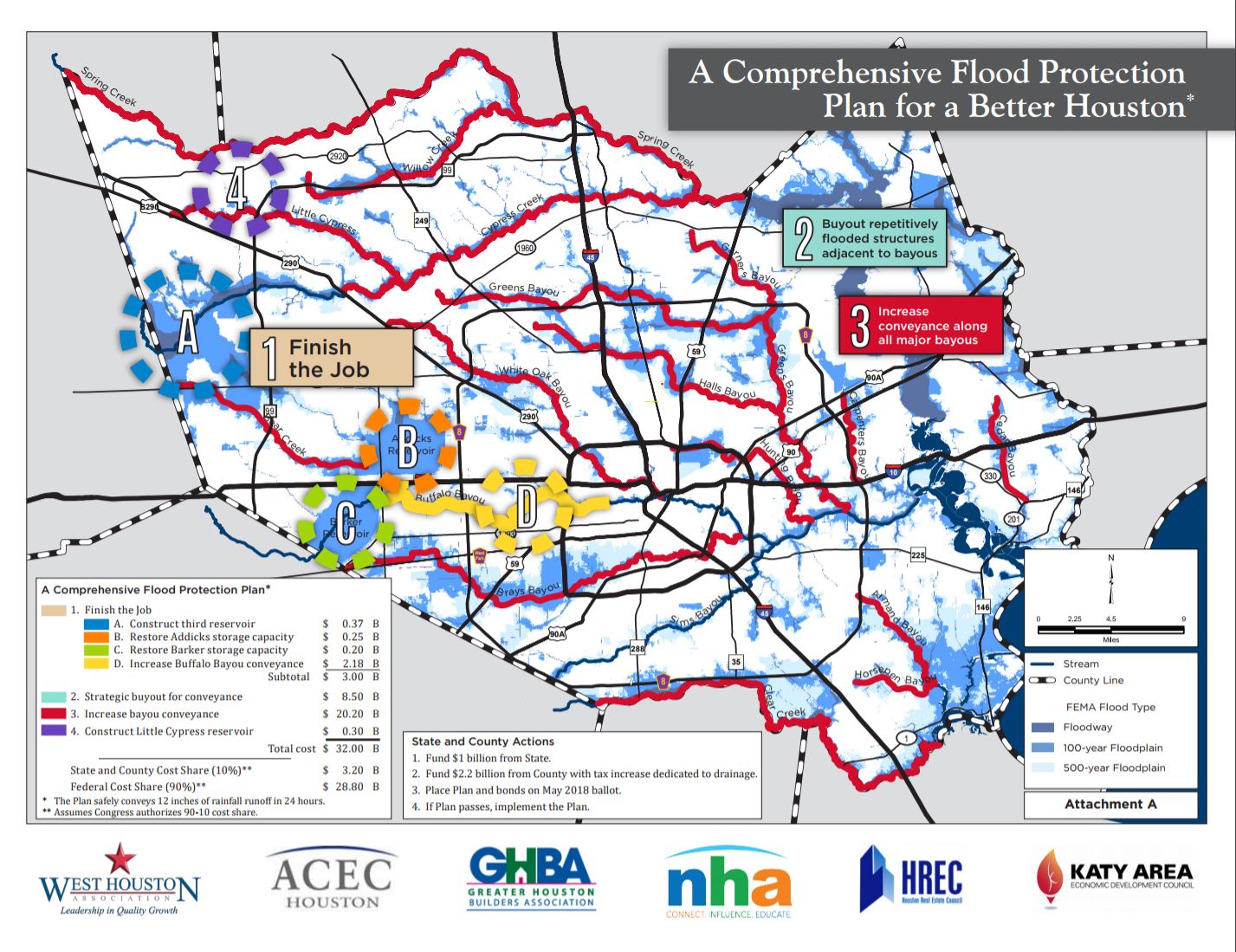Originally published in the Houston Business Journal.
Since 2001, the Houston area has been affected by five major storms that cost 283 lives and over $130 billion in economic damages. The cost of Hurricane Harvey alone was 82 lives and $80 billion in economic damages.
Our elected leaders are responding and recently announced an $18.7 billion request for funding for projects to respond to Hurricane Harvey. After Hurricanes Katrina, the New Orleans region received $76 billion, and after Superstorm Sandy, the New York region received $49 billion for projects.
The entire Harvey-affected area deserves similar assistance. Our region is a critical part of the U.S. economy and we need a comprehensive solution.
Our regional solution
We believe that a comprehensive solution to flooding issues just in Harris County will likely exceed $32 billion and must cover at least three types of projects: Increased storage, increased conveyance and home buyouts.
1. For increased storage, our basic message to our federal officials and the U.S. Army Corps of Engineers is simply this: Let’s fix the flood control storage we have and finish the flood control projects outlined in the 1940 USACE Plan. Let’s restore and maintain Barker and Addicks reservoirs to the capacity that existed when they were constructed by the U.S. Army Corps of Engineers. This effort will include any repairs if necessary to the dam structures and entail removal of all silt and all invasive trees and growth that have intruded upon the reservoirs.
We need to build the third reservoir on Cypress Creek, as proposed by the Harris County Flood Control District in 2015, which was part of the 1940 USACE Plan in order to manage the Cypress Creek overflow. Harris County Flood Control has estimated the Cypress Creek overflow into Barker and Addicks reservoirs during Harvey was an astounding 65,000 acre-feet. Barker and Addicks reservoirs cannot be properly operated to prevent upstream and downstream flooding without the construction of the Cypress Creek overflow reservoir. It was the right plan in 1940 and is now a critical element for the sustainability of our region— from Katy to downtown.
2. For increased conveyance, our flood control and prevention is only as good as our ability to get storm water safely down our bayous and creeks and to the Gulf of Mexico. We have a number of choke points in these channels, which today cannot handle more than six inches of rain per day. All bayou systems in the region must be capable of conveying a 100-year storm event. Our plan will require buying additional rights-of-way in each of the 22 watersheds in Harris County and expansion of existing channels in each of these watersheds. Getting these rights-of-way will include buying many homes that have been subject to repetitive flooding.
The current allowable release rate down Buffalo Bayou is 4,000 cubic feet per second. Barker and Addicks reservoirs, which release exclusively into Buffalo Bayou, have a combined release capacity of 16,000 cubic feet per second. This is unacceptable. The USACE should be required by law to change the operational parameters for Barker and Addicks reservoirs and to address the inadequate capacity for releases and other issues that came to light during Harvey.
3. Regarding home buyouts, prior to FEMA drawing flood maps in the 1970s, hundreds of thousands of homes were built in areas that are now recognized as floodways and 100-year flood plains. Harris County and the city of Houston must implement an aggressive buyout of properties that have experienced flooding on multiple occasions. Flood victims from the 2015 Memorial Day Floods are just receiving buyout checks. A buyout program with less red tape will allow homeowners to move on with their lives. It will also mitigate or eliminate future damages from repetitive flooding.
How to pay for it
Our local, state and federal elected representatives must work quickly on a funding plan that provides for a 90 percent federal share and a 10 percent state and local share. We need the funding expedited, and we need it to be styled “emergency appropriation” with streamlined, responsible permitting requirements. We also need the state to contribute $1 billion in funding to help with the rainiest days in our nation’s history.
Additional tax revenue must be dedicated exclusively to flood control. Harris County voters should get the chance next May to decide whether to increase the tax rate for HCFC from 2.8 cents to 7 cents to support a bond issue of roughly $2.2 billion to fund the local match required for our plan. We’re talking about $8 per month for the average homeowner for a better, more sustainable, most necessary future.
In our view, it is time for our everyone to step up and think big. We need to take decisive, responsible action. We need to make this a more livable and safer region not just for our 6.7 million current residents but also for the approximately 10 million residents projected to live here by 2040.

